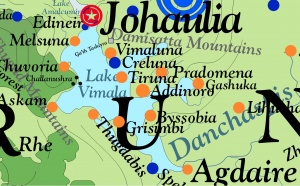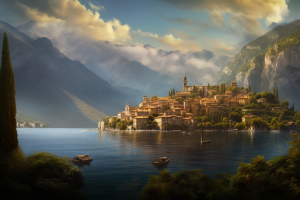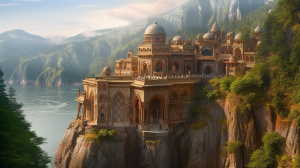Lake Vimala
The highland lake of the Republic of Johaulia has been honored since antiquity as one of the sacred springs of creation and a dwelling-place for the gods and their minions. Lake Vimala /vih-~MAH-la/ was sacred in turn to ancient Kalamans, ancient Midretassenes, during the Yophenthean Empire, and continuing up to the modern day. The name Vimala originates from the ancient Kalaman name of the god Bhimala, the divinity that is believed to occupy and preside over the body of water.
Geography
Bounded on nearly all sides by steep or sloping hills, the lake receives water from the Plateau of Midretasso and drains through a system of locks and dikes into the sea, pouring down the Great Cataracts of Liluthio across from the City of Johaulia into Lake Amalcumir, a sister lake which is also well above sea level. The surface of Lake Vimala rests at 3.8 DF (613 meters or 2011.15 feet) above sea level. In the twenty seventh century (2619), The lake's depth was measured to at least 2.075 DF (334 meters or 1096 feet) deep towards its center. Lake Vimala is about 171 ddwmir (112 km or 70 miles) long at its greatest extent. One of the principal tongues of land that reaches into the lake from the east is Takshuhona Peninsula on the tip of which rests the historic city of Addinoro (Aturoksha). The largest river to flow into Lake Vimala is the Danchaspis River which drains much of the Plateau of Midretasso.
The littoral shape of the lake is determined by the topography in which it lies, the mountainous region of the plateau. Many inlets therefore form the coast. The greatest inlets are Gaphsanti Inlet to the north where the Great Cataracts of Liluthio drain the lake into Lake Amalkumir, Thubissa Inlet to the northeast, bounded by Takshuhona Peninsula to its south, Samnara Inlet to the east, bounded by Takshuhona Peninsula to its north, Balumashra Inlet to the southeast, the relatively narrow Sehimbu Odani Inlet to the south, and Padhaphi Inlet to the west. The Takshuhona Peninsula is the largest such body that juts into the lake. As mentioned earlier, it is bounded by roughly parallel inlets to its south and north. In ancient times, the peninsula was often dominated by the city-state of Aturoksha.
There are six major inlets in Lake Vimala: The Gaphsanti Inlet, the Thubissa Inlet, the Samnara Inlet, the Balumashra Inlet, the Sehimbu Odani Inlet, and the Padhaphi Inlet.
Climate and Vegetation
The lake waters temper the climate so that winters are mild and summers moderately warm. Cypress and pines speckle the shores which enjoy abundant rainfall in the winter, spring, and autumn. The climate is known as 'mediterranean rainforest.'
Tradition and History
In deep antiquity, giant tribes, such as the Bara and the Jaktha, established independent cities along its shores. With the gradual collapse of giant civilization in deep antiquity, humans eventually replaced the occupants of these cities. The last major city to fall to the humans was Jukhaulya (Johaulia), roughly three thousand years ago.
The lake continues to be the common point of cultural continuity for Vimalian civilization and is more populous than the mountain plateau to the east of the lake.
In near ancient times, lake dragons threatened the peace of voyagers and residents, until heroes of the Midretassene Empire slew all water-dwelling dragons centuries ago, most notably the semi-divine hero, Addan, for which the city of Addinoro (Aturoksha) was renamed.
Religion and Worship
The deified personification of Lake Vimala is the god, Lord Vimal. The god, Atur, is the traditional guardian divinity of Lord Vimal and thus of the lake. Atur is the offspring of the goddess Vahmu and the god Hesukh. Atur, like Thwar (Tuvar, Azephassus, etc.), is the god of rain and associated with the Great Flood of Aturyanda. Kashkama, (Liluthio), the god of rivers and streams, is also worshiped. He is the namesake of the Great Cataracts of Liluthio which in Vimalian is Bhalba Kashakama.
Temples around Lake Vimala
Temples and shrines dot the coastline of the lake and legends recount the exploits of the god Lord Vimal, the god, Liluthio, and other divinities who are thought to inhabit the waters or visit the surrounding hills. By tradition, there are fifteen most sacred temples associated with Lake Vimala. Pilgrims often will visit all or most of these temples.
The city of Addinoro (Aturoksha) is home to the Great Temple of Atur, (Temple of Atur of the Great Flood). The other famous shrine in Aturoksha is the Temple of Lord Vimal of the Pilgrims which rests on a stone pediment above the water line of Lake Vimala just off the shore of the city.
Climate
The climate is described as 'Mediterranean Rainforest' with generally rainy, with heavy rains in early spring and late summer. Snow is extremely rare on the shores of the lake. Winter rains are gentle and unceasing. Cities and sites along the west coast of Lake Vimala receive abundant, but relatively less rain. Rains are usually due to large weather systems dumping precipitation onto the plateau of central Corundy and mountain effect rain on the eastern shore of the Lake and weather systems hit the Damisatta Mountains. These rains along with the lake's depth serve to keep it full through the millennia despite the drainage through the water falls of the north.
Transportation
The lake easily affords itself to transportation throughout the central territory of the republic and has done so since ancient times. Boats, barges, and even rafts ensure that the humblest person is not limited to his home town. Commercial traffic is typical on the western shore of the lake, bearing wares between Agdaire in the south and Johaulia to the north.
See Also
- City of Johaulia
- Corundy
- Damisetta Mountains
- Great Cataracts of Liluthio
- Great Valley of Lord Vimal
- Lake Amalcumir
- Republic of Johaulia
- Vimal
| This article is a stub. It requires further development by the creator. |


